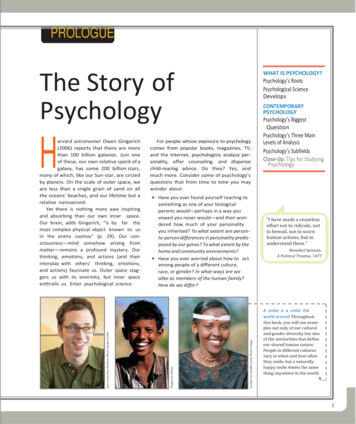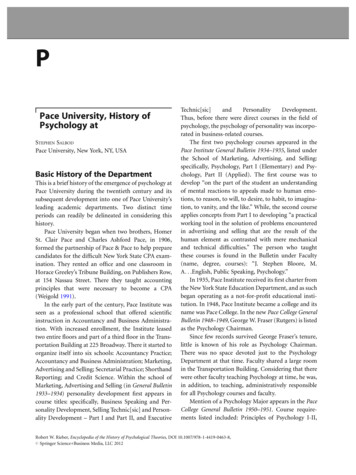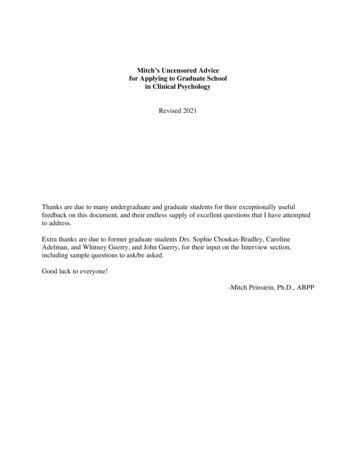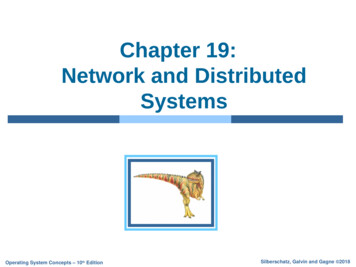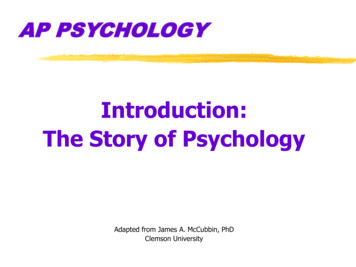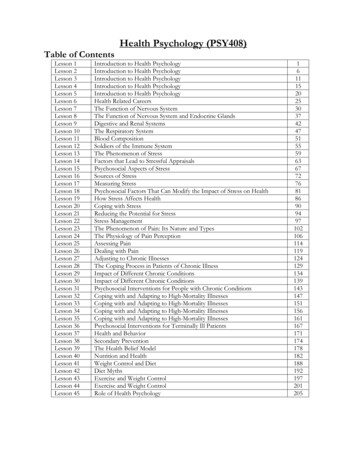
Transcription
Health Psychology (PSY408)Table of ContentsLesson 1Lesson 2Lesson 3Lesson 4Lesson 5Lesson 6Lesson 7Lesson 8Lesson 9Lesson 10Lesson 11Lesson 12Lesson 13Lesson 14Lesson 15Lesson 16Lesson 17Lesson 18Lesson 19Lesson 20Lesson 21Lesson 22Lesson 23Lesson 24Lesson 25Lesson 26Lesson 27Lesson 28Lesson 29Lesson 30Lesson 31Lesson 32Lesson 33Lesson 34Lesson 35Lesson 36Lesson 37Lesson 38Lesson 39Lesson 40Lesson 41Lesson 42Lesson 43Lesson 44Lesson 45Introduction to Health PsychologyIntroduction to Health PsychologyIntroduction to Health PsychologyIntroduction to Health PsychologyIntroduction to Health PsychologyHealth Related CareersThe Function of Nervous SystemThe Function of Nervous System and Endocrine GlandsDigestive and Renal SystemsThe Respiratory SystemBlood CompositionSoldiers of the Immune SystemThe Phenomenon of StressFactors that Lead to Stressful AppraisalsPsychosocial Aspects of StressSources of StressMeasuring StressPsychosocial Factors That Can Modify the Impact of Stress on HealthHow Stress Affects HealthCoping with StressReducing the Potential for StressStress ManagementThe Phenomenon of Pain: Its Nature and TypesThe Physiology of Pain PerceptionAssessing PainDealing with PainAdjusting to Chronic IllnessesThe Coping Process in Patients of Chronic IllnessImpact of Different Chronic ConditionsImpact of Different Chronic ConditionsPsychosocial Interventions for People with Chronic ConditionsCoping with and Adapting to High-Mortality IllnessesCoping with and Adapting to High-Mortality IllnessesCoping with and Adapting to High-Mortality IllnessesCoping with and Adapting to High-Mortality IllnessesPsychosocial Interventions for Terminally Ill PatientsHealth and BehaviorSecondary PreventionThe Health Belief ModelNutrition and HealthWeight Control and DietDiet MythsExercise and Weight ControlExercise and Weight ControlRole of Health 178182188192197201205
Health Psychology (PSY408)VULESSON 01INTRODUCTION TO HEALTH PSYCHOLOGYPrologue“Wide load” the boys shouted as they pressed themselves against the walls of the hallway at school. Theywere ‘making room for a very overweight girl named Sara to pass through. Lunch time in the cafeteria waseven more degrading for Sara because when she sat down to eat; her schoolmates would stop eating, stare ather every move, and make pig noises. “Kids can be cruel.” her parents would say to console her. One ofSara’s aunts told her that she inherited a glandular problem, and you can’t do anything about it.” andanother aunt said, “You’ll lose weight easily in a couple of years when you start getting interested in boys.”Is either aunt right?Sara’s parents are concerned about her weight because they know that overweight people often have socialproblems and face special health risks, particularly for high blood pressure and heart disease. But herparents are not sure why she is so heavy or how to help her. Although her father is a bit overweight, hermother is very heavy; was heavy as a child, and did not lose weight when she became interested in boys.This could support the idea of an inherited cause of her being overweight. On the other hand, they knowSara eats a lot of fattening foods and gets very little exercise, a combination that often causes weight gains.As part of their effort to change these two behaviors, they encouraged her to join a recreation program,where she will be Involved in many physical activities.This story about Sara illustrates important issues related to health. For instance, being overweight isassociated with the development of specific health problems and may affect the individual’s social relations.Also, weight problems can result from a person’s inheritance and his or her behavior.What is Health?What is health? How do you know when you are healthy? To answer these questions, let’s first considerwhat illness is. We define a disease as a characteristic grouping of physical signs and symptoms; it is given aspecific name and can often be traced to a specific causal agent. Illness, however, is a broader term thatinvolves people’s beliefs about the state of their physical well-being and the resulting behaviors they engagein.Illness beliefs may be the result of a specific disease or just the way we feel when we say we are ill (evenwhen there is no evidence of a disease).Illness is important because it is what motivates people to seek out a physician. A disease is what thephysician recognizes as a specific disorder based on known signs and symptoms. Therefore, a physician islikely to define health as the absence of disease, while the average person might define health more broadly;as the absence of any ill feelings.In both of these definitions, however, health is described in terms of what it is not—as the absence ofdisease or illness.We commonly think about health in terms of an absence of(1) Objective signs that the body is not functioning properly, such as measured high blood pressure, or(2) Subjective symptoms of disease or injury, such as pain or nausea.Dictionaries define health in this way, too. But there is a problem with this definition of health. Let’s seewhy.Consider Sara, the overweight girl in the opening story. You’ve surely heard people say. “It’s not healthy tobe overweight,” Is Sara healthy? What about someone who feels fine but whose lungs are being damagedfrom smoking cigarettes or whose arteries are becoming clogged from eating foods which are high in Copyright Virtual University of Pakistan1
Health Psychology (PSY408)VUsaturated fats? These are all signs of improper body functioning. Are people with these signs healthy? Weprobably would say they are not “sick”—they are just less healthy than they would be without theunhealthful conditions.This means health and sickness are not entirely separate concepts—they overlap. There are degrees ofwellness and of illness. Medical sociologist Aaron Antonovsky (1979, 1987) has suggested that we considerthese concepts as ends of a continuum, noting that “We are all terminal cases. And we all are, so long asthere is a breath of life in us, in some measure healthy”. He also proposed that we revise our focus, givingmore attention to what enables people to stay well than to what causes people to become ill.The Illness-wellness ContinuumIn this way, health refers to a positive state of physical, mental, and social wellbeing—not simply theabsence of injury or disease—that varies over time along a continuum. At the wellness end of thecontinuum, health is the dominant state. At the other end of the continuum, the dominant state is illness orinjury, in which destructive processes produce characteristic signs, symptoms, or disabilities.Health and Wellness DefinedIn 1947, the World Health Organization (WHO) defined health as “the state of complete mental, physical,and social well-being, not merely the absence of disease” (WHO, 1947). WHO’s definition was the firstglobally accepted conceptualization of health and stood the test of time for more than a decade.Although multifaceted, this definition of health was flawed, according to members of a new movementcalled holistic health. The holistic health movement came into being in the 1960s as an attempt to expandthe view of health that WHO had spread.One of the early pioneers in the field, Halbert Dunn (1962), believed that WHO’S vision of healthcharacterized it as a static state. Rather than call health a state of well-being, Dunn preferred to view it as acontinuum. Developing and maintaining a high level of health means moving toward high-level functioningalong a continuum that starts with low-level wellbeing and ends with optimal functioning. Health is aconscious and deliberate approach to life and being, rather than something to be abdicated to doctors andthe healthcare system. Optimal health is a result of your decisions and behavior.In addition, Dunn recast the notion of wellbeing to revolve around how well a person functions. That is, heviewed functioning as evidence of well-being. Although people will have setbacks in their quest for optimalfunctioning, the direction in which their lives are moving becomes an important criterion for evaluatingtheir wellbeing. In this movement, daily habits and behaviors, as well as overall lifestyle, assume primaryimportance. Copyright Virtual University of Pakistan2
Health Psychology (PSY408)VUOriginally, the scope of well-being was limited to three dimensions: physical, social, and mental. Adherentsof holistic health argued that the mental dimension has two components—the intellectual (rational thoughtprocesses) and the emotional (feelings and emotions). Each of these domains deals with a different aspectof psychological well-being. An additional dimension, the spiritual, was added because it was thought thathumans could not function optimally in a spiritual vacuum. Therefore, the holistic definition of health hasfive dimensions: physical, social, emotional, intellectual, and spiritual.In the 1970s and 1980s, the definition of health was expanded once again by the wellness movement(Ardell, 1985). Wellness is an approach to health that focuses on balancing the many aspects or dimensions(physical, social, spiritual, emotional, intellectual, and environmental/occupational) of a person’s life byincreasing the adoption of health-enhancing conditions and behaviors rather than by attempting tominimize conditions of illness (AAHE, 2001).A key element of the wellness model is striving for balance. When all of the six dimensions are at high levelsand in balance, we have optimal health and well-being. When the dimensions are out of balance or one isseverely lacking, we have lower levels of health and well-being.Another important part of wellness is the process of becoming healthier. The journey (becoming the bestone can be) is more important than the ending. The process of wellness involves becoming increasinglymore aware of health and making healthy choices.The Six Dimensions of WellnessPhysicalThe first dimension, physical well-being, is reflected in how well the body performs its intended functions.Absence of disease—although an important influence—is not the sole criterion for health. The physicaldomain is influenced by your genetic inheritance, nutritional status, fitness level, body composition, andimmune status, to name just a few factors.IntellectualIntellectual well-being is the ability to process information effectively. It involves the capability to useinformation in a rational way to solve problems and grow. This dimension includes issues such as creativity,spontaneity, and openness to new ways of viewing situations. To maintain a high level of intellectual wellbeing, you must seek knowledge and learn from your experiences. Ideally, your college experiences will haveadded to your intellectual well-being (Figure 1.4).EmotionalEmotional well-being means being in touch with your feelings, having the ability to express them, and beingable to control them when necessary. Optimal functioning involves the understanding that emotions are themirror of the soul. Emotions help us get in touch with what is important in our lives. Our emotions makeus feel alive and provide us with a richness of experience that is uniquely human.SocialSocial well-being involves being connected to others through various types of relationships. Individuals whofunction optimally in this domain are able to form friendships, have intimate relationships, give and receivelove and affection, and accept others unconditionally. They are able to give of themselves and share in theJoys and sorrows of being part of a community. This community includes both formal and informalnetworks. Formal networks include organizations such as churches, professional organizations, fraternities,sororities, and campus groups requiring official membership, dues, and standards. Informal networks, such Copyright Virtual University of Pakistan3
Health Psychology (PSY408)VUas an intramural sports team, do not have rigid rules for membership. In a sense, your social networks are amajor part of your environment.SpiritualSpirituality is a belief in or relationship with some higher power, creative force, divine being, or infinitesource of energy (Fowle; 1986). This belief is manifested in a sense of interconnectedness, a feeling thatsomehow, some way, we are all in this together. For people whose spirituality is religion- based, it isecumenical in scope. It is part of but transcends individual religions. Those whose spirituality is religionbased believe in a supreme being or higher supernatural force and subscribe to a formalized code ofconduct. For individuals whose spirituality is secular, it is universal or even extraterrestrial. In a secularsense, spirituality could manifest itself through connection to something greater than oneself. Whether it isbeing part of a community, working to save the environment, helping to feed the needy, or beingcommitted to world peace, the underlying feeling is a perception of life as having meaning beyond the self(Richards & Bergin, 1997).Spirituality is a two-dimensional concept. The first dimension relates to one’s relationship with thetranscendent (a connection with a higher being or power). The second dimension is connected to one’srelationship with the self, others, and the environment. A continual interrelationship links the twodimensions. Feeling connected with a higher power or being gives us faith and hope and helps us believe wecan do things to make life meaningful. Believing in oneself and feeling connected with others and one’scommunity empowers us to act. Those with a high level of spiritual health behave in an interconnected way(Harris et al., 1999). They take part in church and/or community activities. They help others. They getinvolved in causes and groups that are proactive, whether it involves cleaning up a vacant lot or a beachwith an environmental group or visiting the sick and infirm who arc hospital bound. It is in the “doing” thatsome of the greatest benefits of spirituality are derived (Harris et al., 1999; Richards & Bergin, 1997).EnvironmentalEnvironmental well-being involves high-level functioning on two levels. The most immediate environment,the micro-environment, consists of your school, home, neighborhood, and work site. The people withwhom you interact in those places link the environment to the social aspects of your health. Thisenvironment greatly affects your overall health and personal safety by influencing whether you are at risk forand fear issues such as theft, crime, and violence. The quality of air and water, noise pollution, crowding,and other issues that affect your stress level are also included.Your social support system is also part of this environment. The macro-environment, the level of wellbeingat a larger level—state, country, and the world at large—also affects wellness. The wars in Iraq andAfghanistan, the terrorist attacks of September 11, 2001, and other issues such as violence, internationaldisputes, racism, sexism, heterosexism, and ageism—all influence us daily to some extent. When this book’sauthors were in college, the Vietnam War was going on. College-age men started each day by reading thenewspaper to see which draft numbers were being called up (all draft-eligible men were issued draftnumbers) and if any of their friends were killed or missing in action. Decisions that our political leadersmake, such as engaging in wars or determining where we store radioactive wastes, affect the way we thinkand live our lives. Our ability to stay focused and whole is constantly challenged by the media, which bringthe entire world and its problems into our living rooms each night. We need to learn to think globally, actlocally, and be happy despite the myriad of problems in the al well-being involves issues related to job wiliness. It encompasses everything fromthe safety of your particular work site to the nature of your career. Work-site well-being includes bothphysical (e.g., air, water, physical plant, machinery) and social (e.g., relationships with coworkers, Copyright Virtual University of Pakistan4
Health Psychology (PSY408)VUmanagement, health and wellness facilities and activities) factors. Your personal wellness is affected by thehealth of your work site. Employers and work sites vary tremendously in relation to health. Some strive foroptimal levels, encouraging employees to take advantage of a myriad of health-enhancing programs andservices. Others merely meet the minimum acceptable standards for health and safety set by thegovernment.Besides the specific health of the workplace, different jobs pose varying threats to individuals’ wellbeing as aresult of the nature of the work. Some jobs, such as police and military service, are risky because of possibleexposure to hostile combatants. Other occupations, such as those of firefighters, emergency medical serviceworkers, coal miners, arid oil rig operators, are risky because they place employees in dangerousenvironments. Still other occupations are characterized by high stress due to deadlines, competition, orother factors. Copyright Virtual University of Pakistan5
Health Psychology (PSY408)VULESSON 02INTRODUCTION TO HEALTH PSYCHOLOGYChanging Patterns of Illness Today and In The PastPeople in the United States and other developed, industrialized nations live longer, on the average, than theydid in the past, and they suffer from a different pattern of illness. During the 17th, 18th and 19th centuries,people in North America suffered and died chiefly from two types of illness: dietary and infectious.Dietary diseases result from malnutrition—for example, beriberi is caused by a lack of vitamin t31 and ischaracterized by anemia, paralysis, and wasting away.Infectious diseases are acute illnesses caused by harmful matter or microorganisms, such as bacteria orviruses, in the body. In most of the world today, infectious diseases continue to be the main causes of death(WHO. l999c).A good example of the way illness patterns have changed in developed nations comes from the history ofdiseases in the United States. From the early colonial days in America through the 18th century, colonistsexperienced periodic epidemics of many infectious diseases, especially smallpox, diphtheria, yellow fever,measles, and influenza. It was not unusual for hundreds, and sometimes thousands. of people to die in asingle epidemic. Children were particularly hard hit. Two other infectious diseases. malaria and dysentery,were widespread and presented an even greater threat. Although these two diseases generally did not killpeople directly, they weakened their victims and reduced the ability to resist other fatal diseases. Most, if notall, of these diseases did not exist in North America before the European settlers arrived—the settlersbrought the infections with them—and the death toll among Native Americans was extremely high. Thishigh death rate occurred for two reasons. First, the native population had never been exposed to these newmicroorganisms, and thus lacked the natural immunity that our bodies develop after lengthy exposure tomost diseases (Grob, 1983). Second. Native Americans’ immune functions were probably limited by a lowdegree of genetic variation among these people (Black, 1992).In 19th century infectious diseases were still the greatest threat to the health of Americans, The illnesses ofthe colonial era continued to claim many lives, but new diseases began to appear. The most significant ofthese diseases was tuberculosis, or “consumption as it was often called. In 1842, for example consumptionwas listed as the cause for 22% of all deaths in the state of Massachusetts (Grob, 1983). But by the end ofthe 19th century deaths from infectious diseases had decreased sharply. For instance, the death rate fromtuberculosis declined by about 60% in a 25’year period around the turn of the century.Did this decrease result mostly from advances in medical treatment? Although medical advances helped tosome degree, the decrease occurred long before effective vaccines and medications were introduced. Thiswas the case for most of the major diseases we’ve discussed, including tuberculosis, diphtheria, measles, andinfluenza.It appears that the decline resulted chiefly from preventive measures such as improved personal hygiene,greater resistance to diseases (owing to better nutrition), and public health innovations, such as buildingwater purification and sewage treatment facilities. Fewer deaths occurred from diseases because fewerpeople contracted them.The 20th century has seen great changes in the patterns of illness afflicting people, particularly in developednations where advances in preventive measures and medical care have reduced the death rate from lifethreatening infectious diseases (WHO, 1999c). At the same time, the average life expectancy of people hasincreased dramatically. At the turn of the century in the United States, the life expectancy of babies at birthwas about 48 years (USDHHS. 1987); today it is 76 years (USBC, 1999). Copyright Virtual University of Pakistan6
Health Psychology (PSY408)VUBabies who survived their first year in 1900 could be expected to live to about 56 years of age. Survivingthat first year added seven years to their expected total lie span. Moreover, people in 1900 who had reachedthe age of 20 years could expect to live to almost 63 years of age. Today the death rate for Americanchildren is much lower, and only a small difference exists in the expected total life span for newborns and20-year-olds.Death is still inevitable, of course, but people die at later ages now and from different causes. The mainhealth problems and causes of death in developed countries today are chronic diseases—that is,degenerative illnesses that develop or persist over a long period of time. About two-thirds of all deaths indeveloped nations are caused by three chronic diseases: heart disease, cancer, and stroke (WHO, l999c).These diseases are not new, but they were responsible for a much smaller proportion of deaths before the20th century. Why? One reason is that people’s lives are different today. For example, the growth ofindustrialization increased people’s stress and exposure to harmful chemicals. In addition, more peopletoday survive to old age, and chronic diseases are more likely to afflict the elderly than younger individuals.Thus, another reason for the current prominence of chronic diseases is that more people are living to theage when they are at high risk for contracting them.Are the main causes of death in childhood and adolescence different from those in adulthood? Yes. In theUnited States, for example, the leading cause of death in children and adolescents, by far, is not an illness,but accidental Injury (USBC. 1999). Nearly 40% of child and adolescent deaths result from accidents,frequently involving automobiles. In childhood, the next two most frequent causes of death are cancer andcongenital abnormalities; in adolescence, they are homicide and suicide {USBC, 1999). Clearly the role ofdisease in death differs greatly at different points in the life span.Viewpoints from History:Physiology, Disease Processes and the MindIs illness a purely physical condition? Does a person’s mind play a role in becoming ill and getting well?People have wondered about these questions for thousands of years, and the answers they have arrived athave changed over time.Early CulturesAlthough we do not know for certain, it appears that the best educated people thousands of years agobelieved physical and mental illness were caused by mystical forces, such as evil spirits (Stone. 1979). Whydo we think this? Researchers found ancient skulls in several areas of the world with coin-size circular holesin them that could not have been battle wounds. These holes were probably made with sharp stone tools ina procedure called trephination. This procedure was done presumably for superstitious reasons—for instance,to allow illness-causing demons to leave the head. Unfortunately, we can only speculate about the reasonsfor these holes because there are no written records from those times.Ancient Greece and RomeThe philosophers of ancient Greece produced the earliest written ideas about physiology, disease processes,and the mind between 500 and 300 B.C. Hippocrates, often called the Father of Medicine, proposed ahumoral theory to explain why people get sick. According to this theory, the body contains four fluids calledhumors (in biology, the term humor refers to any plant or animal fluid). When the mixture of these humors isharmonious or balanced, we are in a state of health. Disease occurs when the mixture is faulty (Stone, 1979).Hippocrates recommended eating a good diet and avoiding excesses to help achieve humoral balance.Greek philosophers, especially Plato, were among the first to propose that the mind and the body areseparate entities. This view is reflected in the humoral theory: people get sick because of an imbalance in Copyright Virtual University of Pakistan7
Health Psychology (PSY408)VUbody fluids. The mind was considered to have little or no relationship to the body and its state of health.This remained the dominant view of writers and philosophers for more than a thousand years.Many people today still speak about the body and the mind as if they were separate. The body refers to ourphysical being, including our skin, muscles, bones, heart and brain. The mind refers to an abstract processthat includes our thoughts, perceptions, and feelings. Although we can distinguish between the mind andthe body conceptually, an important Issue is whether they also function independently. The question oftheir relationship is called the mind/body problem.Galen was a famous and highly respected physician and writer of the 2nd century A.D. who was born inGreece and practiced in Rome. Although he believed generally in the humoral theory and the mind/bodysplit, he made many innovations. For example, he dissected animals of many species (but probably never ahuman), and made important discoveries about the brain, circulatory system. pd kidneys’ (Stone. 1979. p. 4).From this work, he became aware that illnesses can be localized, with pathology in specific parts of thebody, and that different diseases have different effects. Galen’s ideas became widely accepted.The Middle AgesAfter the collapse of the Roman Empire In the 5th century A.D., much of the Western world was indisarray. The advancement of knowledge and culture slowed sharply in Europe and remained stuntedduring the Middle Ages, which lasted almost a thousand years. Galen’s views dominated Ideas aboutphysiology and disease processes for most of this time.The influence of the Church in slowing the development of medical knowledge during the Middle Ages wasenormous. According to historians, in the eyes of the Church the human being was regarded as a creaturewith a soul, possessed of a free will which set him apart from ordinary natural laws, subject only to his ownwillfulness and perhaps the will of God. Such a creature, being free-willed, could not be an object ofscientific investigation. Even the body of man was regarded as sacrosanct, and dissection was dangerous forthe dissector. These strictures against observation hindered the development of anatomy and medicine forcenturies.The prohibition against dissection extended to animals as well, since they were thought to have souls, too.People’s ideas about the cause of illness took on pronounced religious overtones, and the belief in demonsbecame strong again. Sickness was seen as God’s punishment for doing evil things. As a result, the Churchcame to control the practice of medicine, and priests became increasingly involved in treating the III, oftenby torturing the body to drive out evil spirits.It was riot until the 13th century that new ideas about the mind/body problem began to emerge. The Italianphilosopher St. Thomas Aquinas rejected the view that the mind and body are separate. He saw them as aninterrelated unit that forms the whole person. Although his position did not have as great an impact asothers had had, it renewed interest in the issue and influenced later philosophers.The Renaissance and AfterThe word renaissance means rebirth—a fitting name for the 14th and 15th centuries. During this period inhistory, Europe saw a rebirth of inquiry, culture, and politics. Scholars became more human-centered” thanGod-centered” in their search for truth and believed that truth can be seen In many ways, from manyindividual perspectives”(Leahy, 1987. p. 80). These ideas set the stage for important changes in philosophyonce the scientific revolution began after 1600.The 17th-century French philosopher and mathematician Rene Descartes probably had the greatest Copyright Virtual University of Pakistan8
Health Psychology (PSY408)VUinfluence on scientific thought of any philosopher in history. Like the Creeks, he regarded the mind andbody as separate entities, but he introduced three important innovations.First, he conceived of the body as a machine and described the mechanics of how action and sensationoccurred. Second, he proposed that the mind and body, although separate, could communicate through thepineal gland, an organ in the brain. Third, he believed that animals have no soul and that the soul in humansleaves the body at death. This belief meant that dissection could be an acceptable method of study —apoint the Church was now ready to concede.In the 18th and 19th centuries, know-ledge in science and medicine grew quickly, helped greatly by thedevelopment of the microscope and the use of dissection in autopsies. Once scientists learned the basics ofhow the body functioned and discovered that microorganisms cause certain diseases, they
Lesson 4 Introduction to Health Psychology 15 Lesson 5 Introduction to Health Psychology 20 Lesson 6 Health Related Careers 25 Lesson 7 The Function of Nervous System 30 Lesson 8 The Function of Nervous System and Endocrine Glands 37 Lesson 9 Digestive and





